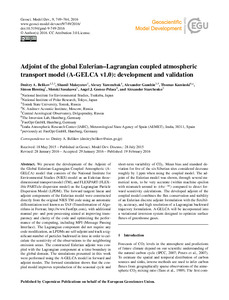Por favor, use este identificador para citar o enlazar este ítem:
http://hdl.handle.net/20.500.11765/1020
Adjoint of the global Eulerian–Lagrangian coupled atmospheric transport model (A-GELCA v1.0): development and validation
| Título : | Adjoint of the global Eulerian–Lagrangian coupled atmospheric transport model (A-GELCA v1.0): development and validation |
| Autor : | Belikov, Dmitry A.; Maksyutov, Shamil; Yaremchuk, Alexey; Ganshin, Alexander; Kaminski, Thomas; Blessing, Simon; Sasakawa, Motoki; Gómez Peláez, Ángel Jesús



|
| Palabras clave : | A-GELCA model; Carbon dioxide; Particle dispersion model; Modelos acoplados; Concentración de dióxido de carbono; Modelos matemáticos |
| Fecha de publicación : | 2016 |
| Editor: | European Geosciences Union |
| Citación : | Geoscientific Model Development. 2016, 9, p. 749-764 |
| Versión del editor: | https://dx.doi.org/10.5194/gmd-9-749-2016 |
| Resumen : | We present the development of the Adjoint of the Global Eulerian–Lagrangian Coupled Atmospheric (A-GELCA) model that consists of the National Institute for Environmental Studies (NIES) model as an Eulerian three-dimensional transport model (TM), and FLEXPART (FLEXible PARTicle dispersion model) as the Lagrangian Particle Dispersion Model (LPDM). The forward tangent linear and adjoint components of the Eulerian model were constructed directly from the original NIES TM code using an automatic differentiation tool known as TAF (Transformation of Algorithms in Fortran; http://www.FastOpt.com), with additional manual pre- and post-processing aimed at improving transparency and clarity of the code and optimizing the performance of the computing, including MPI (Message Passing Interface). The Lagrangian component did not require any code modification, as LPDMs are self-adjoint and track a significant number of particles backward in time in order to calculate the sensitivity of the observations to the neighboring emission areas. The constructed Eulerian adjoint was coupled with the Lagrangian component at a time boundary in the global domain. The simulations presented in this work were performed using the A-GELCA model in forward and adjoint modes. The forward simulation shows that the coupled model improves reproduction of the seasonal cycle and short-term variability of CO2. Mean bias and standard deviation for five of the six Siberian sites considered decrease roughly by 1 ppm when using the coupled model. The adjoint of the Eulerian model was shown, through several numerical tests, to be very accurate (within machine epsilon with mismatch around to ±6 e−14) compared to direct forward sensitivity calculations. The developed adjoint of the coupled model combines the flux conservation and stability of an Eulerian discrete adjoint formulation with the flexibility, accuracy, and high resolution of a Lagrangian backward trajectory formulation. A-GELCA will be incorporated into a variational inversion system designed to optimize surface fluxes of greenhouse gases. |
| URI : | http://hdl.handle.net/20.500.11765/1020 |
| ISSN : | 1991-959X 1991-9603 |
| Colecciones: | Artículos científicos 2015-2018 |
Ficheros en este ítem:
| Fichero | Descripción | Tamaño | Formato | ||
|---|---|---|---|---|---|
| gmd-9-749-2016.pdf | 7,15 MB | Adobe PDF |  Visualizar/Abrir |
Los ítems de Arcimis están protegidos por una Licencia Creative Commons, salvo que se indique lo contrario.





